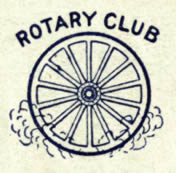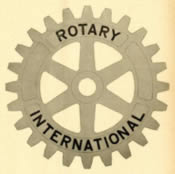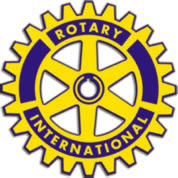
The Story of The Rotary Wheel
A wheel has been the symbol of Rotary since our earliest days. In 1905, Montague M. Bear, an engraver and member of the Rotary Club of Chicago, sketched a wagon wheel with 13 spokes as a Club emblem. When fellow Club members began to complain that the design was static and lifeless, Bear added flourishes that made the wheel appear to ride on a bed of clouds. Unfortunately, some members felt the clouds looked like dust, defying the laws of physics by being kicked up on both sides of the wheel. Bear responded by superimposing a banner with the words "Rotary Club" over the clouds. The wheel was said to illustrate "Civilization, Movement and Service work in action." Most of the early Clubs had some form of wagon wheel on their publications and letterheads.

In 1918, a Rotarian engineer by the name of Oscar Bjorge said that the "emblem was an insult to engineering that only the brain of an artist could conceive." He said that not only were the cogs irregularly spaced, but also a cogwheel with 19 cogs would not work. He therefore designed a new one with 24 cogs and six spokes which symbolized the six objectives of Rotary at the time. He also added a keyway which locks a wheel to a hub, thus making it a "worker and not an idler." The keyway in the center of the hub is of great significance because it represents the individual Rotarian member, who is the key factor in every Club. Quality members are the keys, needed for the hub to engage with the shaft and turn, putting the energy into motion and creating the power for the gears to do their work.
In 1922, it was decided that all Rotary Clubs should adopt a single design as the exclusive emblem of Rotarians, so the present gear wheel with 24 teeth and six spokes was adopted by the "Rotary International Association." The gear teeth around the outside represent the fact that work is to be done. The six spokes represent the inner direction and path of our Vocational Service, through the representation of our membership via the classification system. Similarly, these same spokes represent an outward distribution path of Rotary's ideals of service and the Four Way Test… going out toward the community, vocations and businesses that our members represent.

At the 1929 Rotary International Convention, it was determined that blue and gold would be the official colors of the organization, so the wheel was designed with these colors. The four blue bands within the outer radius of the gear represent our four avenues of service, and the design which we now know was formally adopted as the official Rotary International emblem.


Next: Proceedings of 1924 RI Convention: Lancaster Rotarians perform song. |